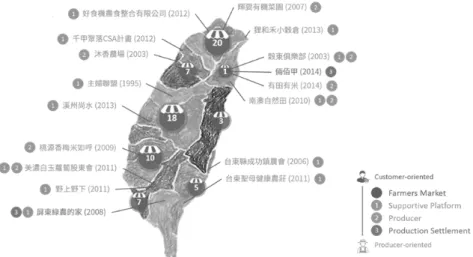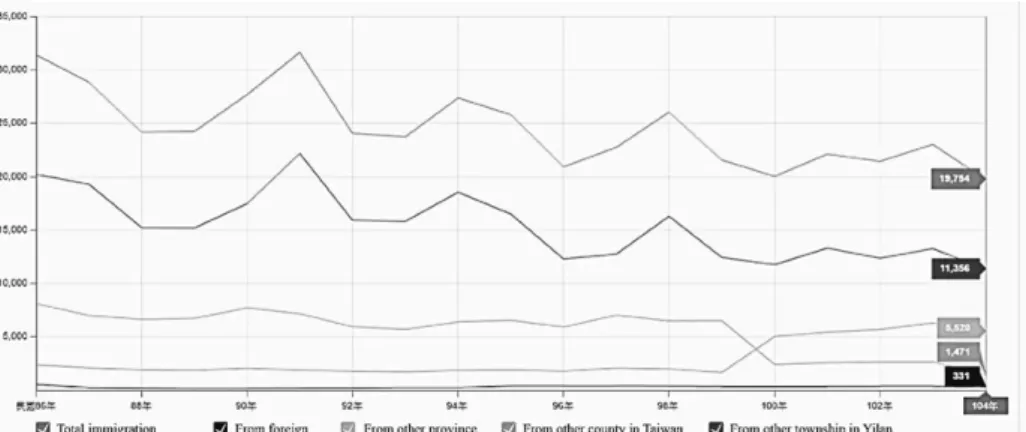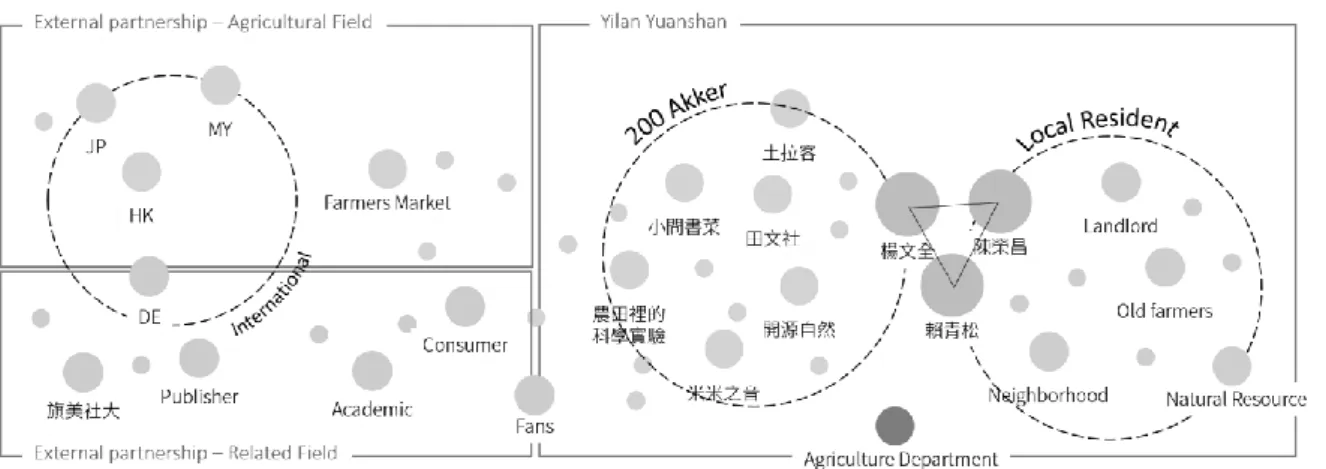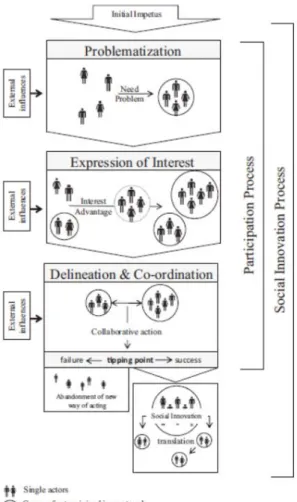Exploring the Creative Rural Milieu for Agricultural Renaissance:
a case study of 200 Akker in Taiwan
Shu-Ting Yeh
Master Student, Institute of Creative Industries Design, National Cheng Kung University, Tainan, Taiwan E-mail: pa6044057@mail.ncku.edu.tw
Hui-Wen Lin
Associate Professor, Institute of Creative Industries Design, National Cheng Kung University, Tainan, Taiwan E-mail: hwlin@mail.ncku.edu.tw
Abstract
In the past few decades, agriculture reveals its value in multiple dimensions for sustainable development by various agricultural innovative action as reconnecting the relationship of agri-food, people and land. This phenomenon defined by scholars as Agricultural Renaissance forms the specific agricultural life style and culture in Taiwan. Those innovative actions contributing to agriculture are from different backgrounds and practices of actors forming the learning network and sharing the resources, knowledge and information in agriculture addition to aim for sustainable development. Furthermore, the issue on how to attract creative talents to form the learning and sharing network in rural areas is considered a rising awareness. This paper aims to propose how the creative milieu treated as a physical environment with soft infrastructure of networking and hard infrastructure for learning, sharing and inspiration enhances the condition of actors aiming for Agricultural Renaissance.
This research used case study and content analysis explores the case of 200 Akker in Taiwan which owns characteristics of creative rural milieu to attract creative talents joining the Agricultural Renaissance actions. The research finding reveals that the creative rural milieu attracting creative talents to join Agricultural Renaissance actions by providing a comfortable and inviting surrounding with a common goal for agricultural sustainability, high tolerance in agricultural obstacles, as well as setting up innovative and creative ideas from diverse actors to deal with the problem in the production process and also the settlement as a village for strong relationship in networking.
Keywords: Creative Milieu, Agriculture, Agricultural Renaissance, Sustainable Development, Network, Learning, Innovation, Creative
1. Introduction
In the past few decades, agriculture reveals its value in multiple dimensions for sustainable development through various agricultural innovative and creative actions as reconnecting the relationship between agri-food, people and land around the world (Lyson, 2004; SACHS, 2015). The role of agriculture is beyond the function as productivity and those innovative and creative practices have transformed the content of rural society and agriculture from traditional ways (Cooke, 1996; Jr
&Cobb, 1989; Keiner, 2006; Millenium Ecosystem Assessment, 2010; Soil and Water Conservation Bureau, 2015). Furthermore, “Agricultural Renaissance” describes the generation created by those innovative and creative practices in agriculture that the core value of those practices is trying to reveal the value of agriculture and echo to the global issue as disaster society nowadays (Lii, 2011;
Tsai, 2016). Those actors for innovative practices in agriculture gather together to form a network to spread the ideas, resources, information and knowledge for doing the practice of agriculture.
Agriculture Renaissance highlights the influences from innovative practices of agriculture from three aspects: the image of farmer from negative to positive; the attention of agri-issues from low to high;
the sphere of agriculture from rural to urban. It demonstrates the transformation of agriculture and the value of those actions (Tsai, 2016).
Tracing back to the evolution of Agriculture Renaissance which related to rural development, the government policy always plays a dominant role in rural development through the policy and the allocation of resources in Taiwan (Chuang, 2001). Since 1950, the government proposed a series of policies to promote economic growth in Taiwan. The strategy was gradually transferring the resource and focus from agricultural sector to industrial sector and changed rural structure. The impact is misleading the rurality of rural area and also losing the value of agriculture as balance the rural society (Hu, 1978; Kun-Sun Shiao, 1999). On the other hand, the power from people always try to find a way out to balance the government role (Tsai, 2014). Thus, some social movements was launched for rurality and agriculture in some fields around 1980s (J.Chen, 2016; Y. N.Wu, 2007).
Till now, most of the actors from movements are still engaging in the field. To sum up, within the development path in Taiwan, the approach gradually transferred from government-led to civil-led and it forms the era of Agricultural Renaissance. The core concept of Agricultural Renaissance is that the heterogeneous actors taking innovative actions and building the network for coordination to emphasizes not only the economic value of agriculture, but also its multiple functions in fostering environmental stewardship, community livelihood, local food sovereignty, and regional biodiversity (Tsai, 2016). In the study by Jonathan Murdoch (2000), the researcher proposed that the network with concerning innovation and learning provides a new paradigm of rural development. For addressing sustainability in regional development, social learning of the network triggers the innovative and creative actions (Sol, Beers, &Wals, 2013).
The issue on how to attract creative talents to form the learning and sharing network in rural areas is considered a rising awareness. This paper aims to propose how the creative milieu treated as a physical environment with soft infrastructure of networking and hard infrastructure for learning, sharing and inspiration enhances the condition of actors in Agricultural Renaissance era.
2. Learning and innovative in Agricultural Renaissance
Since 19 century, the chemical and industrial farming paradigms oriented from Europe and the United States have led the development of global agriculture in the name of green revolution and modernization in the post-World War II era. In recent years, it has been actively promoting energy, technology and capital in genetically modified crops and more intensive single cropping patterns.
However, around 1960-1970, there’s some trend as practice the alternative farming which rethinking the industrial farming from biological environmental perspective by various movements from both consuming and production side (Lyson, 2004). In the study of Lii (2011), the researcher defined the current situation as a disaster society which the extreme climate, global warming, financial tsunami, economy depression affect our life and we need to face the dilemma and find some way out. Thomas A. Lyson (2004) introduced the civil agriculture which reconnecting farm, food, and community through various actions, such as community-supported agriculture (CSA) which was from Japanese
“Teikei”. CSA is a co-farming performance to encourage people to go to the field and interact with producer. There are many different actions occurred in various places to reveal the value and multifunctional of agriculture including to society and the environment. The term Agricultural Renaissance combines the word “agriculture” and “art” together in Chinese. Renaissance means the actions show the respect to the original farming ways as the useful art to get along with the nature instead of removing the agriculture technical part with chemical fertilizers. It was defined into three perspective: the agro-Ideology, agro-translation and agro-arts. The agro-ideology presents the value of agriculture from productive to innovative, educational, etc. and the scale of agriculture from agriproduct to culture, society, and ecology. In production phase, the actors as producer they don’t want to use the conventional farming way which removes the technical and knowledge part from farming in nature. Instead, they use the ecological way for farming and solve the questions during the process. Furthermore, in consumption phase, those actors as cultural intermediaries deliver the value of agriculture to society through aesthetic expression.
The actions in Agricultural Renaissance era are refer to learning and innovation for echoing the dilemma and uncertainty condition nowadays. Learning is an effective process of managing change in agricultural and natural resource management under conditions of high uncertainty (Kroma, 2008).
The innovative processes are the outcome of collaborative networks where information is exchanged and learning processes happen. The way of how coordinating with diverse actors. But most of them only focus on human actors and ignore the importance of the learning environment as non-human actors. And the study will focusing on both human and non-human actors and the environmental factors.
3. Creative milieu for creative cluster
Economists, sociologists, and regional planners have been engaged in studying the contents and factors of innovation-driven development. The studies firstly focused on the physical service provided by region such as traffic, quality of the living environment for the regional development and then the relationship within geographically rounded regional communities. Thus, the concept creative milieu is frequently used in numerous discussions along with various complementary concepts such as learning regions, industrial districts, innovative clusters that emphasize the geographical dimensions of the linkage of science and technology centers with other economic networks and the close institutional and personal involvement in the social environment, which has important spatial implications on the regional level (Ravbar, Bole, &Nared, 2005). In The Creative City, the creative milieu was defined as a space and the prerequisites of gathering creative class (Landry, 2008). It is a physical environment let people interact and inspire ideas face to face. The
environment contains hard infrastructure, such as a building could support service, some research institution, etc.; and also soft infrastructure, such as social network, social relationship, interpersonal interaction, etc. The creative milieu should consolidate and promote the flow of ideas between individuals and institutions as a system (Landry, 2008).
4. Current situation of Agricultural Renaissance in Taiwan
Based on the secondary data collection, a current diffusion map of the Agricultural Renaissance in Taiwan (Fig. 1). There are four categories divided by customer-oriented or producer-oriented as farmers market, supportive platform which collaborate with other farmers to promote the product through common platform, producer and production settlement which gathers a group of farmers to do the organic farming or friendly farming as a community. The research would like to focus on production settlement because of the network is the strongest and the manner of co-learning and sharing is the most obvious which is benefit for attracting more actors gather together through the literature review.
Figure 1. Current map of Agricultural Renaissance diffusion
Among the map, 200 Akker is one of the representative Agricultural Renaissance case in Yilan.
Within the history of Taiwan local development, Yilan County has its own unique autonomy because of the geographic location and environmental protection policy proposed by Chen, Ding-nan in 1980s (Xiao, Xin Huang; Ji, Jun Jie; Huang, 2008). In 2005, the Huehshan tunnel was opened. The time from Taipei to Yilan has been decreased. Besides the tourism promotion as the development strategy, more and more people could experience the natural scenery in Yilan. The image of Yilan comes into people’s mind the beautiful nature environment and fresh air. Even in 2013, Yilan won the international awards for livable community. In recent years, some immigration come to Yilan (Fig. 2) to start their new life. Some study shows the phenomenon as the migrators take Yilan as their new hometown and they decide to fulfill their dream about life here. For them, the most important motivation is to perform a new life experiment which related to living quality and home environment and also try to complete their own life practice (I.-C.Wu, 2011). Furthermore, some of the migrators decide to be a farmer which applying friendly farming to the environment for their life practice. A study demonstrates more clear image of those “new” farmers (new means the migrators is new to local) (J.-H.Chen, 2016). In short, because of the special condition of Yilan, some people would like to return to rural to live and try to complete their own life practice as new and friendly to the
environment farmers here. Yilan is one of the best field for Agricultural Renaissance (Tsai, 2016).
200 Akker was founded by Yang, Wen-Chang and Lai, Chin-Sung in 2012. They position themselves as an incubation for migrators who don’t have the agricultural background but wants to be a producer. Actually, they are more like the small society in community form instead of organization. The way they gather together is just like neighborhood and the old times rural society:
Mutual trust and assistance. In the literature of Agricultural Renaissance, it describes this cooperation as “no consensus cooperation” which to reveal the cooperation between different communities. It doesn’t mean there’s no consensus between them. Instead, members of 200 Akker all follow the principle as friendly farming (no harm to the environment). But they can use their own way to practice the principle. Because there’s no best way or formulation for farming, these actors they just keep trying and get along with the nature and respect it. Thus, it can be concluded that the common principle in 200 Akker is friendly to the nature and the members (actors) could practice it through various ways.
Figure 2. Immigration statistic from 1997 to 2015 (Resource: The government archive) 5. Research Design
This section will introduce the research target, research construct, and research framework. At this stage, this research design is under progress and designed based on the current circumstance of Agricultural Renaissance in Taiwan.
5.1 Research Target
In order to know how the creative milieu formed for learning, sharing and inspiration enhances the condition of actors aiming for Agricultural Renaissance, the stakeholders of Agricultural Renaissance in 200 Akker should be clarified first. The stakeholders could be categorized into internal and external part by using the boundary of region (Fig. 3). In internal part, there’s two main group of stakeholders, one is 200 Akker and the other one is local resident. One of the characteristic of 200 Akker is that almost all of the member are migrators. They come to Yuanshan to rent the land and the build the relationship with local resource and residents. And the public sector engages in by the way as giving support or implying some related policy. For external part, the stakeholders could be divided into involved in agricultural filed or in other related Agricultural Renaissance field. And the figure shows the prototype of the Agricultural Renaissance actor network in 200 Akker.
Figure 3. Stakeholders’ relationship of 200 Akker
In detail, to highlight the actors of within the relation network. The following figure (Tab. 1) categorizes the stakeholders into different categories based on the work they contribute to the networking. The figure demonstrates the stakeholders are heterogeneous which included the human and non-human and diverse. And the categories actually highlight the different part of the Agricultural Renaissance action. So that the Agricultural Renaissance in 200 Akker could be comprehensive.
Table 1. Category of actors in 200 Akker
5.2 Research Construct and Framework
The research construct of the study will be based on the combination of the model of social innovation process as Figure 4 proposed by Stefan Neumeier (2016) and the elements of creative milieu as Figure 5 (Landry, 2008). Innovation always concludes the learning process which helps the actors in Agricultural Renaissance developing creative solutions for agricultural farming; meanwhile, the creative milieu provides a good foundation for attracting creative talent and inspiring creative ideas together. The study applies the combination model of the social innovation process and elements of creative milieu in agriculture field to clarify the factors in 200 Akker for proposing how the creative milieu treated as a physical environment with soft infrastructure of networking and hard infrastructure for learning, sharing and inspiration enhances the condition of actors aiming for Agricultural Renaissance.
Figure 4. Schematic illustration of the social innovation process
Figure 5. Elements of creative milieu (Compiled by author)
In generally speaking, this research adopted model of social innovation process as the horizontal axis of the analytical framework and the concept of creative milieu as the vertical axis of the analytical framework for analyzing 200 Akker. Under this framework, this research used case study and content analysis explores the case of 200 Akker in Taiwan which owns characteristics of creative rural milieu to attract creative talents joining the Agricultural Renaissance actions.
6. Research Results
The research finding reveals that the creative rural milieu attracting creative talents to join Agricultural Renaissance actions by providing a comfortable and inviting surrounding with a common goal for agricultural sustainability, high tolerance in agricultural obstacles, as well as setting up innovative and creative ideas from diverse actors to deal with the problem in the production process and also the settlement as a village for strong relationship in networking (Fig. 6).
Figure 6. Creative rural milieu for Agricultural Renaissance Reference
1. Chen, J. (2016). In the Name of the Farmer: A Historical Review of Agrarian Movements in Postwar Taiwan. A Journal of Cultural Studies, (22), 75–122.
2. Chen, J.-H. (2016). New Farmer Phenomenon Of Yilan County. Fo Guang University.
3. Chuang, S. (2001). A Typological Research of Rural Development on Taiwan. National Taiwan University.
4. Cooke, P. (1996). The new wave of regional innovation networks: Analysis, characteristics and strategy.
Small Business Economics, 8(2), 159–171. https://doi.org/10.1007/BF00394424
5. Hu, T.-L. (1978). The Evolving Agricultural Communities: Development and Types of Agro - industry in a Suburban Community. Publications of the Institute of Ethnology, Academia Sinica, 46, 79–111.
6. Jr, H. D., &Cobb, J. (1989). For the Common Good: Redirecting the Economy Toward Community, the Environment, and a Sustainable Future. Boston: Beacon Press.
7. Keiner, M. (2006). The future of sustainability. The Future of Sustainability, (January), 1–257.
https://doi.org/10.1007/1-4020-4908-0
8. Kroma, M. M. (2008). Organic Farmer Networks: Facilitating Learning and Innovation for Sustainable Agriculture. Journal of Sustainable Agriculture, 28(4), 5–28. https://doi.org/10.1300/J064v28n04_03 9. Kun-Sun Shiao. (1999). An Analysis of the Concept of Rural Restructuring, 13.
10. Landry, C. (2008). The Creative City: A Toolkit for Urban Innovators. Marco Polo Press.
11. Lii, D. (2011). Civic Agriculture and Social Reconstruction. Taiwan: A Radical Quarterly in Social Studies, 84, 431–464.
12. Lyson, T. A. (2004). Civic agriculture : reconnecting farm, food, and community. Medford, Mass: Tufts University Press ; Hanover, NH : University Press of New England.
13. Millenium Ecosystem Assessment. (2010). Ecosystems and Human Well-Being: Biodiversity Synthesis.
Ecosystems, 285. https://doi.org/10.1057/9780230625600
14. Murdoch, J. (2000). Networks - A new paradigm of rural development? Journal of Rural Studies, 16(4), 407–419. https://doi.org/10.1016/S0743-0167(00)00022-X
15. Neumeier, S. (2016). Social innovation in rural development: identifying the key factors of success. The Geographical Journal. https://doi.org/10.1111/geoj.12180
16. Ravbar, M., Bole, D., &Nared, J. (2005). A creative milieu and the role of geography in studying the competitiveness of cities: the case of Ljubljana. Acta Geographica Slovenica, 45(2), 7–34.
https://doi.org/10.3986/AGS45201
17. SACHS, J. D. (2015). The Age of Sustainable Development.
18. Soil and Water Conservation Bureau, C. (Ed.). (2015). Learning with the Village Life. Taiwan: Soil and Water Conservation Bureau.
19. Sol, J., Beers, P. J., &Wals, A. E. J. (2013). Social learning in regional innovation networks: Trust, commitment and reframing as emergent properties of interaction. Journal of Cleaner Production, 49, 35–43. https://doi.org/10.1016/j.jclepro.2012.07.041
20. Tsai, Y. (2014). Farming Life, Farming Resistance. A Journal of Cultural Studies, 18, 217–226.
21. Tsai, Y. (2016). Agricultural Renaissance in Taiwan. A Journal of Cultural Studies, (22), 23–74.
22. Wu, I.-C. (2011). Creating New Hometown: A Study on Lifestyle Migration in Yilan. National Chiao Tung University.
23. Wu, Y. N. (2007). Where is the Jiang-Ho? The observation of Taiwanese agriculture. INK.
24. Xiao, Xin Huang; Ji, Jun Jie; Huang, S. M. (2008). Deepening Local Sustainable Development:
Taiwan’s Nine Counties-Cities Examined. Cjuliu Publisher.




